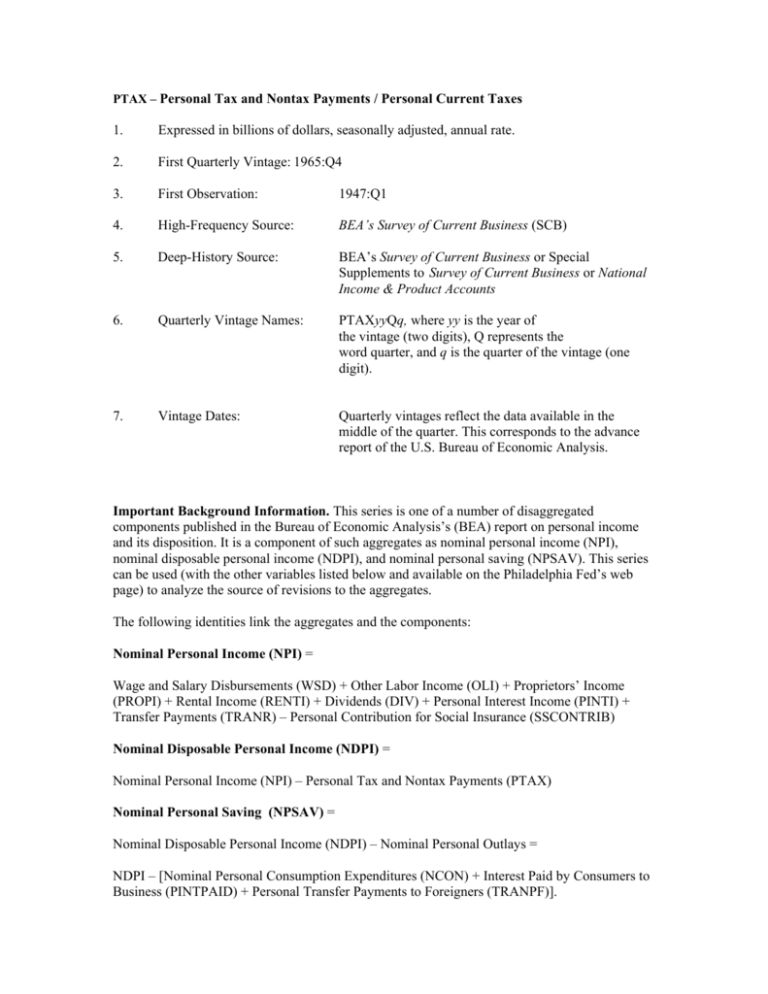Specific notes on data collected for personal tax & nontax payments
advertisement

PTAX – Personal Tax and Nontax Payments / Personal Current Taxes 1. Expressed in billions of dollars, seasonally adjusted, annual rate. 2. First Quarterly Vintage: 1965:Q4 3. First Observation: 1947:Q1 4. High-Frequency Source: BEA’s Survey of Current Business (SCB) 5. Deep-History Source: BEA’s Survey of Current Business or Special Supplements to Survey of Current Business or National Income & Product Accounts 6. Quarterly Vintage Names: PTAXyyQq, where yy is the year of the vintage (two digits), Q represents the word quarter, and q is the quarter of the vintage (one digit). 7. Vintage Dates: Quarterly vintages reflect the data available in the middle of the quarter. This corresponds to the advance report of the U.S. Bureau of Economic Analysis. Important Background Information. This series is one of a number of disaggregated components published in the Bureau of Economic Analysis’s (BEA) report on personal income and its disposition. It is a component of such aggregates as nominal personal income (NPI), nominal disposable personal income (NDPI), and nominal personal saving (NPSAV). This series can be used (with the other variables listed below and available on the Philadelphia Fed’s web page) to analyze the source of revisions to the aggregates. The following identities link the aggregates and the components: Nominal Personal Income (NPI) = Wage and Salary Disbursements (WSD) + Other Labor Income (OLI) + Proprietors’ Income (PROPI) + Rental Income (RENTI) + Dividends (DIV) + Personal Interest Income (PINTI) + Transfer Payments (TRANR) – Personal Contribution for Social Insurance (SSCONTRIB) Nominal Disposable Personal Income (NDPI) = Nominal Personal Income (NPI) – Personal Tax and Nontax Payments (PTAX) Nominal Personal Saving (NPSAV) = Nominal Disposable Personal Income (NDPI) – Nominal Personal Outlays = NDPI – [Nominal Personal Consumption Expenditures (NCON) + Interest Paid by Consumers to Business (PINTPAID) + Personal Transfer Payments to Foreigners (TRANPF)]. Please note that the long-name descriptors are those that the BEA used in 1965. Since then the BEA has made occasional changes to the definition and/or names of these variables. We have maintained the use of the original names while collecting these modified variables, so that the aggregation conditions listed above always hold in every vintage, up to a rounding error. Rounding errors of plus or minus $0.1 to $0.2 billion are common. Occasionally, the rounding error can be as large as $0.4 billion. Special Notes. 1. The name of the variable we collect as PTAX has changed over time, in the following order: Personal Tax and Nontax Payments (vintages 1965Q4 to 2003Q4), Personal Current Taxes (vintages 2004Q1 to present). 2. PTAX66Q1 – Unexpected revision. In the vintage 1966:Q1, the observation for 1965:Q2 was revised, with no explanation in the January 1966 SCB. 3. PTAX69Q4 – Unexpected revision. In the vintage 1969:Q4, the observation for 1969:Q1 was revised, with no explanation in the October 1969 SCB. 4. PTAX72Q1 – Unexpected revisions. In the vintage 1972:Q1, the observations for 1971:Q1 and 1971:Q2 were revised, with no explanation in the January 1972 SCB. 5. PTAX82Q3 – Unusually Long Annual Revision. The annual revision in the July 1982 SCB contained revisions for observations 1977:Q1 to 1982:Q1. This period of revised observations is longer than usual, due to the lack of an annual revision in 1981. 6. PTAX86Q1 – Benchmark Revision. The December 1985 Survey of Current Business released the results of a BEA benchmark revision. However, our data for the 1986Q1 vintage comes from special volumes published separately. Observations 1947:Q1 to 1982:Q4 are entered from National Income and Product Accounts, 1929-1982, Statistical Tables, United States Department of Commerce, Bureau of Economic Analysis, September 1986; observations 1983:Q1 to 1984:Q2 are from the March 1986 SCB; observations 1984:Q3 to 1985:Q4 are from the January 1986 SCB. We assume that the data from the first two sources would have been available from the BEA in February, due to availability notes on page 2 of the December 1985 SCB. 7. PTAX92Q1 – Benchmark Revision. On December 4th 1991 the BEA released results from a benchmark revision. For the 1992Q1 vintage, the January 1992 SCB only provides data for observations 1987:Q1 to 1991:Q4. We take observations 1959:Q1 to 1986:Q4 from the November 1991 SCB. 8. PTAX96Q1 – Missing Observation. Because of a delay in the release of statistical data caused by a federal government shutdown, the 1995:Q4 observation is missing in the1996Q1 vintage. 9. PTAX96Q1 to PTAX97Q1 – Short Time Series History. On January 19th, 1996, the BEA released a benchmark revision. Deep history observations were initially reported in the January/February SCB beginning with the observation for 1959:Q1. This short time series history continues until the vintage of 1997Q2, when deep history back to 1947:Q1 were first reported in the May 1997 SCB. 10. PTAX97Q2 – Additional History. This vintage marks the completion of the benchmark revision started in the vintage of 1996Q1. Deep history back to 1947:Q1 is taken from the May SCB. 11. PTAX99Q4 – Short Time Series History. In this vintage observations are only available starting from 1994:Q1 because data prior to 1994 were not reported in our deep-history source. 12. PTAX00Q1 – Short Time Series History. In this vintage observations are only available starting from 1959:Q1 because data prior to 1959 were not reported in our deep-history source. 13. PTAX02Q4 to PTAX03Q4 - Unusual Revisions. In each vintage from 2002Q4 to 2003Q4, revisions were made to the two observations prior to the latest observation (i.e., one period farther back than usual). No explanation was given in the Survey of Current Business. 14. PTAX11Q3 – Flexible Annual Revision. On July 29, 2011, the BEA released a flexible annual revision to the national income and product accounts. Flexible annual revisions may affect more observations than those of the past three years. In addition, flexible annual revisions can incorporate methodological changes to the way in which the BEA constructs the data in the national accounts.



